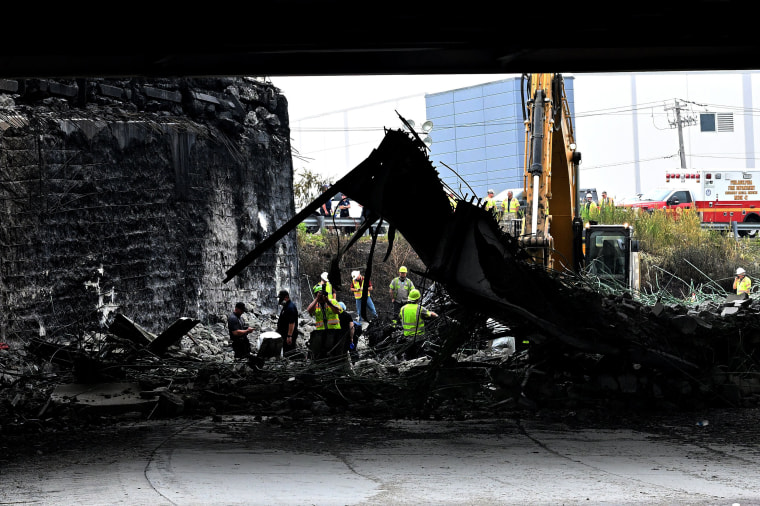A man who was found dead on Monday in the wreckage of the tanker truck fire beneath an Interstate 95 overpass in Philadelphia has been identified by his family.
Family members of Nathaniel “Nate” Moody, who was 53, told NBC Philadelphia he had driven the same route in and around the I-95 ramp all the time.
They also said the driver, a father of three and an Army veteran, had a spotless driving record and had been responsible for delivering gasoline to Wawa gas stations across the region.
Authorities have not yet publicly identified the body pulled from the wreckage. The grim discovery of his remains came as demolition crews prepared to dismantle part of the southbound lanes after the fiery tanker blast Sunday caused a section on the northbound side of the heavily traveled highway to collapse.

Asked at a news conference whether the body found was the driver in the tanker blast, Pennsylvania Transportation Secretary Mike Carroll said, "I will defer to the medical examiner for comment on that."
Moody's cousin, Alex Moody, described the truck driver as a hardworking family man who had been driving trucks for a decade.
“My cousin is a hardworking man. Family man," Alex Moody told NBC Philadelphia. “We’ve always been cool and tight. He’s very mild mannered. Calm guy. Really calm person. He gets along with everybody.”
The lanes were ordered demolished after inspectors discovered that the support beams that hold up the southbound lanes had been severely weakened by Sunday's explosion, which police said happened after the driver of the 8,500-gallon-capacity tanker truck apparently lost control trying to negotiate a curve on the exit ramp and slammed into a wall beneath the interstate. Officials have been referring to the overpass as a bridge.
"The engineering and the inspection of the southbound bridge indicated it's compromised as a result of the fire," Carroll said. "The I-beams are incapable of supporting the traffic, and so that structure has to be removed, and we'll be starting today."

Contractors hired by the state Transportation Department will work around the clock "in an effort to try and speed up the solution," Carroll said.
Pennsylvania Gov. Josh Shapiro has already warned that it could take months to repair the key stretch of highway, which links the East Coast’s two largest cities, New York and Philadelphia, and carries roughly 160,000 vehicles a day.
Carroll said, "We expect that demolition to be completed in four or five days."
The driver of the vehicle in the tanker blast was transporting a shipment of fuel to a local Wawa gas station and had just exited the ramp from I-95 North to Cottman Avenue, which goes underneath the highway, when the tanker exploded.
Police have not divulged whether the driver was killed by the blast or by the 500 tons of concrete, steel and rubble that rained down on the truck after the explosion.
Asked whether the wrecked section of highway had recently been inspected, Carroll said, "The bridge was just fine before the accident."
In fact, the overpass had been refurbished about seven years ago, one of the nation's leading civil engineers said.
"This bridge was rated good by the Pennsylvania DOT, and it recently had a major rehabilitation in 2016," said Andrew Herrmann, a past president of the American Society of Civil Engineers. "The likeliest cause for the collapse here is intense heat. That’s what the investigators are likely focusing on."
Herrmann said that highway overpasses made of concrete and steel appear to be nonflammable but that they are "susceptible to high heat."
"The temperature from a fire of this type could reach 2,000 degrees," Herrmann said. "The steel girders carrying the bridge can lose 50% of its strength at 1,100 degrees. Similarly, concrete can lose 50% of its strength at 950 degrees. This loss of strength can cause sagging and collapse of the structure."
Asked whether this part of the highway will be rebuilt the same way, Carroll said at the news conference that officials are "looking at all the options."
Herrmann said that the overpass met standards of the American Association of Highway and Transportation Officials and that its design is used on highways around the country.
CORRECTION (June 12, 2023, 8:55 p.m. ET): A photo caption in a previous version of this article misstated when the overpass collapsed. It collapsed Sunday, not Monday.
